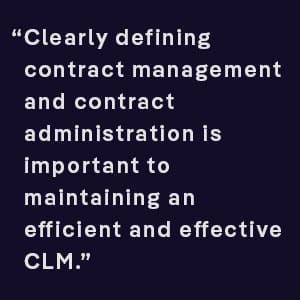Contract administration vs contract management might sound similar, but they are, in fact, very different. Whether your company hires one or both roles, it is important to understand how they both impact successful contract lifecycle management (CLM) — and your bottom line.
This article will explore how the functions vary, yet overlap, and offer best practices for your organization.
What is Contract Administration?
While it is hard to capture all of the important aspects of contract administration, in simple terms, it helps plan, execute, and close a contract — all of the work before an agreement is signed. It is critical that the entire contract management process is performed exceptionally, as it sets the stage for mutually agreeable contracts that ultimately drive business revenue. This can include:
- Sending comprehensive Request for Proposals (RFP) to potential partners
- Setting achievable performance expectations
- Contract planning that stays in scope and on time
- Negotiating prices based on current market demand and company input
- Determining renewal schedules that align with all involved entities
- Ensuring precise contract language that complies with internal and external rules and regulations
- Assessing potential risks
- Creating organized delivery schedules that are sensible and beneficial
An administrator must combine clerical, strategic, and analytical work to create a successful contract. Such work requires an individual to be extremely organized and detail-oriented. It requires them to ensure the contract is clear and defined to avoid any potential confusion or — worse — litigation. Administrators must create contracts that meet and exceed a company’s long-term and short-term goals, helping to reduce extraneous risk and increase profits. Fortunately, contract management (CM) software eases the burdens of performing all of these functions, saving valuable time and creating efficiencies.
Best Practices: Contract Administration
Establish efficient communication channels:
Creating a mutually beneficial contact often involves constant back-and-forth communication between legal teams and other departments. Establishing a consistent form of communication, which can be saved and referenced later, protects all parties from confusion and disparate information.
Set achievable goals and track them:
Defining goals early and tracking their progress gets everyone on the same page and working towards the same outcomes. It keeps processes moving forward and offers insight if changes are needed.
Standardize contract language:
Leveraging standardized and pre-approved contractual terms and conditions helps save valuable time when creating contracts. It also ensures the language is in compliance with current regulatory and internal laws and standards.
Encourage collaboration:
As a single source of contact, contract administrators interact with people from several different teams. Promoting a collaborative environment eases information bottlenecks and facilitates better negotiation and communication.
Provide transparency:
Providing transparency at every step fosters a collaborative environment between all involved parties and promotes positive working relationships in the future. When information is hidden or not accessible, it creates distrust and often slows down the entire process. However, best-in-class companies utilize permission-based systems that allow only approved team members to access contract information, protecting confidentiality.
Create a dispute resolution technique:
When deadlines are not met and set goals are not achieved, contract administrators should have a proven method to correct the issue before it escalates or goes unresolved altogether.
What is Contract Management?
Where contract administration stops, contract management starts. The latter implements all of the important functions of a contract after it is signed. This requires in-depth knowledge of the contract’s terms and conditions, and the ability to oversee it moving forward. These functions can include:
- Ensuring all parties’ contractual compliance
- Confirming contractual obligations are met in a timely manner
- Determining potential breach of contract — before it occurs — if possible
- Problem-solving document questions if they arise
- Clearly communicating the terms internally and externally
- Making necessary changes if the market or law requires them
Legal departments and companies rely on contract managers to diligently monitor a contract throughout its lifecycle. Communication and collaboration skills are imperative for a seamless contract management process, as managers are viewed as the single point of contact for all relevant stakeholders, such as other department heads, suppliers, and contract administrators. Maintaining meticulous records of all correspondence and negotiated changes are key to reducing possible misunderstandings between parties. It is also important to stay up to date with any changes in market regulations or governmental laws that could impact existing contracts. The good news is that legal teams that adopt contract management software can leverage a centralized repository for storing all contracts, automated notifications, and pre-approved language that ensures compliance.
Contract Management: Best Practices
Leverage a centralized contract repository:
Whether your organization has hundreds or thousands of contracts, it is crucial to house them in a secure, centralized location that can be accessed quickly and easily. A best-in-class repository should be searchable, helping to save time and offering permission-based access to uphold confidentiality. Repositories can be cloud-based, allowing users across the business to view agreements anytime and anywhere, or on-premise, on a company’s single desktop.
Define key performance indicators (KPIs):
Measuring a contract’s progress throughout the CM process helps gauge if it is delivering expected results or if changes should be made. A few KPI examples include meeting deadlines and missed milestones, quality assurance, customer satisfaction, renewal percentage, and revenue per client.
Collaborate and communicate:
While legal teams bear the main responsibility for contracts, it is important to have collaboration tools and processes that drive open communication with key stakeholders, including those in executive, sales, and procurement teams. Seamless collaboration helps reduce risk and prevent misinterpretations within the contract’s lifecycle.
Automate notifications:
Contract managers must stay on top of key deadlines, which is extremely difficult when they face thousands of active agreements. But automated notifications, available in contract management software, ease this burden by offering real-time reminders of important dates.
Monitor risk and compliance:
Unfortunately, no matter how well contracts are written, there are potential risks involved with each. Internal compliance and regulatory risk, compromising confidentiality, deadline errors, breach of terms — and many other examples — can be extremely costly to your company’s revenue and reputation. However, experienced contract managers can use contract management software to track and monitor these risks. And quite often, they can anticipate these risks before they even occur.
Contract Management vs Contract Administration
Clearly defining contract management and contract administration is important to maintaining an efficient and effective CLM. While such systems can function independently for day-to-day workflows, properly integrating the roles provides increased visibility, enhanced collaboration, and better oversight. This includes fostering open lines of communication to ensure the contract terms and conditions are completely understood and enforced.
Ultimately, both processes should work together to create positive relationships with outside vendors, suppliers, and other legal teams. In addition, providing full process transparency and sharing goals drives strong contracts that benefit all parties and produce a higher return on investment (ROI). Integrating contract management software into these processes, then, offers a shared, single resource — one that facilitates best practices throughout the contract management process, from start to finish. For more help on choosing the right system for your organization’s needs, check out our whitepaper, How to Choose a Contract Management Solution.
Author:

Jerry Levine
Connect with us on Linkedin











